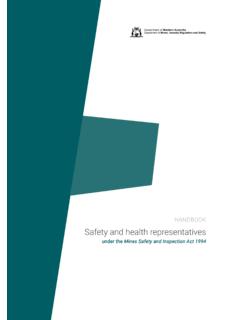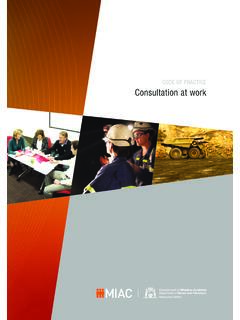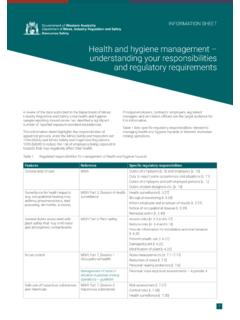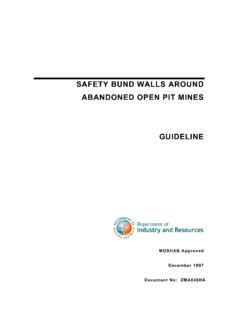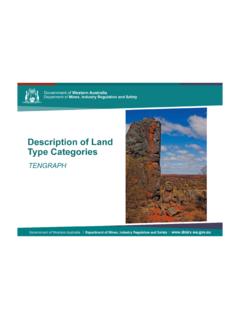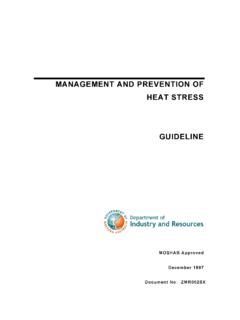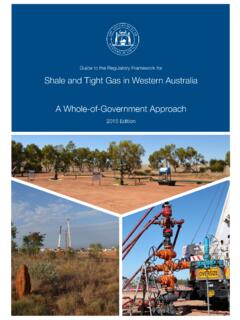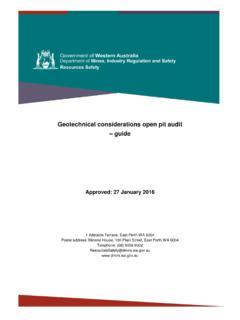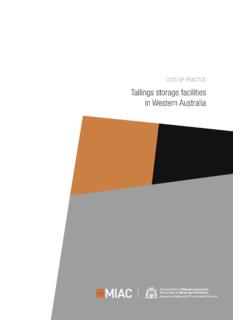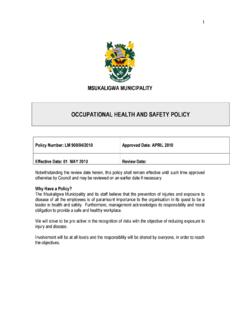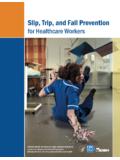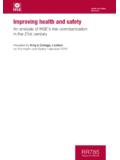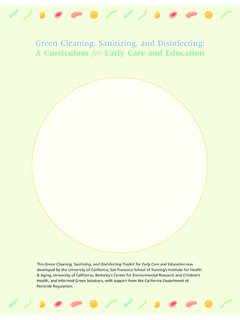Transcription of Risk-based hygiene management planning and CONTAM …
1 Risk-based hygiene management planning and CONTAM system procedures February 2015 1 Adelaide Terrace, East Perth WA 6004 Postal address: Mineral House, 100 Plain Street, East Perth WA 6004 Telephone: (08) 9358 8002 Facsimile: (08) 9358 8000 Risk-based hygiene management planning and CONTAM system procedures Page 2 of 32 Contents Introduction .. 3 Risk-based hygiene management plan (RBHMP) .. 3 Legislation and useful information .. 4 Roles and responsibilities .. 5 Ventilation Officer .. 5 Registered CONTAM sampler .. 5 Responsible Inspector .. 5 CONTAM Manager .. 5 RBHMP and risk assessment .. 6 Establish the goals for the program .. 6 Characterise the workplace .. 6 Establish similar exposure groups (SEGs) .. 7 Risk-assess exposures .. 7 Determine number of employees to sample .. 8 Develop a results strategy .. 8 health hazard control .. 9 RBHMP re-assessment.
2 11 Quota proposals .. 11 CONTAM results .. 12 Appendix 1 CONTAM registered sampler form .. 13 Appendix 2 occupational codes .. 14 Appendix 3 CONTAM sample record sheet .. 21 Appendix 4 Contaminant codes .. 22 Appendix 5 Sampling equipment codes .. 26 Appendix 6 Drilling method codes .. 27 Appendix 7 Location codes .. 28 Appendix 8 Exceedance notification form .. 31 Appendix 9 Measurement conversion .. 32 Risk-based hygiene management planning and CONTAM system procedures Page 3 of 32 Introduction Mine sites are required to carry out a structured risk assessment of their occupational health hazards, and develop a Risk-based hygiene management plan (RBHMP). The RBHMP provides Resources Safety with an overview of the mine-specific occupational health hazards, monitoring programs and control measures, and forms a basis from which the sampling quota can be negotiated. This procedure will define and detail: roles and responsibilities Ventilation Officer Registered CONTAM sampler Responsible Inspector CONTAM Manager how to conduct a health and hygiene risk assessment and develop a RBHMP how to propose a sampling quota how to report sampling results Risk-based hygiene management plan (RBHMP) For greenfield sites, the RBHMP should be prepared in advance of commissioning based on available knowledge of potential occupational exposures.
3 Existing sites should have a RBHMP approved by the Responsible Inspector before the end of each financial year. The RBHMP addresses the questions: What occupational hygiene hazards are employees (including contractors) potentially exposed to? How do the exposures occur what task and what process? What monitoring is conducted? What are the results? What controls are in place? What controls are required? What is the current sampling quota and the proposed sample quota? The RBHMP is intended to accurately describe all health hazards in the operation and the controls required to prevent harm to persons from these. It is a commitment to identify, acknowledge and respond appropriately, and it is a tool that will be used by each Responsible Inspector for auditing purposes. By developing a RBHMP each operation has the opportunity to effectively: characterise their workplace and work force determine actual and potential health hazard exposures risk-assess these exposures detail monitoring requirements to support risk determination or verification define existing and required controls to prevent or reduce exposures to ALARP.
4 The RBHMP will be required to reference a Diesel Emissions management Plan, Fibrous Minerals management Plan or Radiation management Plan where these contaminants are known to exist within an operation. Copies of these documents, if relevant, will need to be submitted with the RBHMP. Risk-based hygiene management planning and CONTAM system procedures Page 4 of 32 Legislation and useful information Applicable legislation, codes of practice, standards and guidance material include: Legislation (Western Australia) Mines Safety and Inspection Act 1994 (the Act) Mines Safety and Inspection Regulations 1995 (the Regulations) Code of Practice (Department of Mines and Petroleum) Prevention and control of Legionnaire s disease Australian Standards AS 2985 Workplace atmospheres Method for sampling and gravimetric determination of respirable dust AS 2986 Workplace air quality Sampling and analysis of volatile organic compounds by solvent desorption/gas chromatography AS 3640 Workplace atmospheres Method for sampling and gravimetric determination of inhalable dust AS/NZS ISO 31000 Risk management Principles and guidelines AS/NZS 4801 occupational health and safety management systems Specification with guidance for use AS/NZS 4804 occupational health and safety management systems General guidelines on principles, systems and supporting techniques National Standards (Safe Work Australia)
5 National standard for manual tasks National standard for limiting occupational exposure to ionizing radiation National standard for occupational noise National standard for the control of inorganic lead at work Adopted national exposure standards for atmospheric contaminants in the occupational environment Hazardous Substances Information System (HSIS, Safe Work Australia) Guidelines (Department of Mines and Petroleum) Adjustment of exposure standard for extended work shifts management and prevention of heat stress management of diesel emissions in Western Australian mining operations management of fibrous minerals in Western Australian mining operations management of noise in Western Australian mining operations Managing naturally occurring radioactive material (NORM) Risk-based health surveillance and biological monitoring Other Guidance Material Guidance note on the membrane filter method for estimating airborne asbestos fibres Approved criteria for classifying hazardous substances Guidance on the interpretation of workplace exposure standards for airborne contaminants Hazardous chemicals requiring health monitoring Risk-based hygiene management planning and CONTAM system procedures Page 5 of 32 health Monitoring for exposure to hazardous chemicals Developing and implementing a health management plan (2010) (Industry and Investment, NSW) Roles and responsibilities Ventilation Officer In relation to a mine, a Ventilation Officer means a person appointed for the mine under regulation In addition to the duties specified in regulation and , the Ventilation Officer is responsible for developing, reviewing and maintaining the RBHMP.
6 The Registered Manager of a mine appoints the Ventilation Officer and notifies the District Inspector in writing. If the Registered Manager considers the scale, scope and nature of the mining operations do not warrant the appointment of a Ventilation Officer, the Registered Manager needs to apply to the District Inspector for an exemption under regulation (4). Regulation specifies the training and qualifications required for an appointed Ventilation Officer in underground and surface mining operations. Note: Where a site has received an exemption for appointment of a Ventilation Officer, or where the Ventilation Officer has insufficient experience or knowledge to develop and maintain a RBHMP, an external, qualified, hygiene contractor or consultant may be utilised. Registered CONTAM sampler The CONTAM system is a Resources Safety electronic database used to store personal mine employee atmospheric contaminant exposure results.
7 Only CONTAM registered samplers may submit results to the CONTAM system. To become a registered CONTAM sampler, the registered sampler form (see Appendix 1) with proof of qualifications must be submitted to the CONTAM Manager for approval. The Surface Ventilation technician and Surface Ventilation officer qualifications meet the required certification criteria. Other qualifications and experience related to occupational hygiene may also meet competency requirements. CONTAM sampler registration lasts for five years. Re-registration will only be approved if evidence of current competency in air monitoring skills can be provided. Responsible Inspector The Inspector or Officer responsible for ensuring the health hazard management and CONTAM systems operate effectively for mine and exploration sites under their jurisdiction is the OSH assignee. For the purposes of this procedure, this person is referred to as the Responsible Inspector.
8 CONTAM M anager The CONTAM M anager is the Department of Mines and Petroleum s administrator of the CONTAM system, and is the link between the mine site and the Responsible I nspector. The CONTAM Manager is responsible for the integrity and quality assurance of the CONTAM database. Risk-based hygiene management planning and CONTAM system procedures Page 6 of 32 RBHMP and risk assessment The following is a step-by-step methodology for conducting a site occupational health hazard risk assessment and developing an effective RBHMP for a mine site. Establish the goals for the program 1. Define the mine site s objectives from a risk based approach. 2. Define roles and responsibilities ( those involved in information gathering, ownership of the program, monitoring, control maintenance, analysis and reporting). Characterise the workplace 1. Prepare a schematic of the workplace detailing the critical processes, equipment and tasks, including exploration, haulage and rehabilitation activities if relevant.
9 2. Conduct hazard identification through a combination of: walking through and observing the workplace examining records of previous incidents and health issues considering potential events and exposures discussing with workers their safety concerns examining available information on hazardous substances and equipment used on site a good source of information is the hazardous substances register checking the geochemistry of ore sources for elevated levels of contaminants. 3. Using the above methods, identify the chemical, physical and biological agents; and ergonomic conditions in the work environment that have the potential to cause harm. Consider: noise potential to cause noise induced hearing loss vibration potential to develop musculoskeletal conditions diesel emissions potential to develop respiratory disease or cancer other atmospheric contaminants, such as dust, gas, vapour, mist, fume, smoke potential to develop acute or chronic health condition other hazardous substance exposures potential to develop contact dermatitis water treatment potential to be exposed to legionella and other biological agents ergonomic stressors potential for musculoskeletal conditions, back problems and fatigue related conditions ultraviolet radiation from sun or welding potential for skin or eye disease heat and cold potential for development of heat related illness ionising radiation potential for development of toxicity or malignancies.
10 4. List the occupational exposure limits for each applicable agent taking into account shift adjustment and site policy requirements. 5. Describe how the workforce is organised and staffed. 6. Identify the processes, operations, tasks and work practices that pose significant exposure to the identified health hazards. 7. Identify existing controls and how they are used. Risk-based hygiene management planning and CONTAM system procedures Page 7 of 32 All components of the RBHMP should be clearly linked. As a minimum, the outputs from this section should include: A schematic identifying the critical processes, equipment and tasks for the whole operation. An accompanying list of associated actual and potential health hazards. This list can appear on the schematic, or in a separate document linked to the schematic. If no health hazards exist for a particular operational component, it is to be identified as such to indicate that the component has been included in the characterisation.
